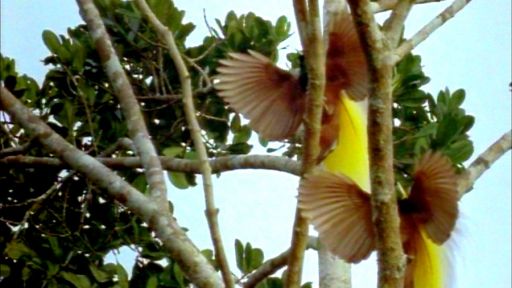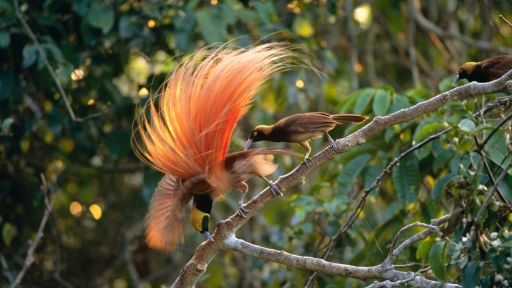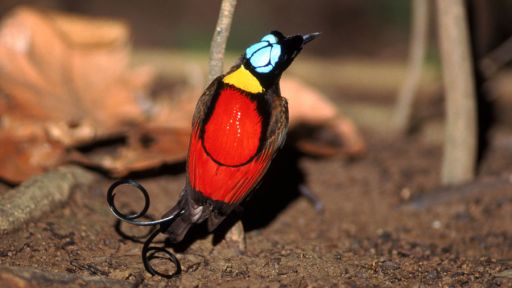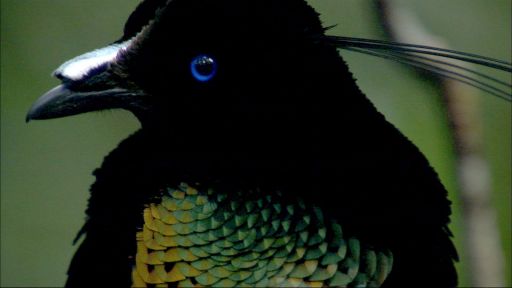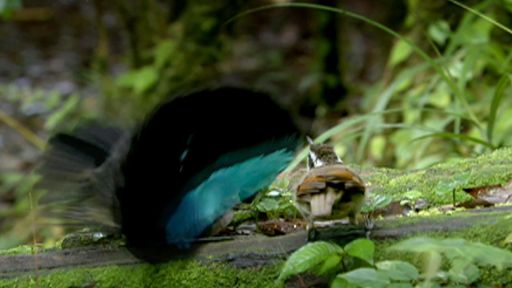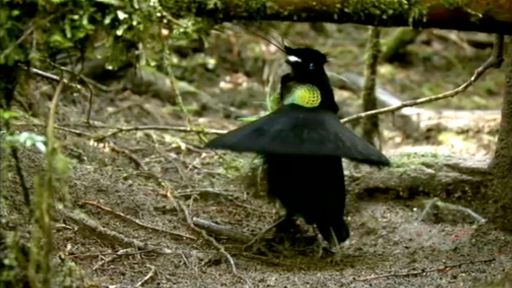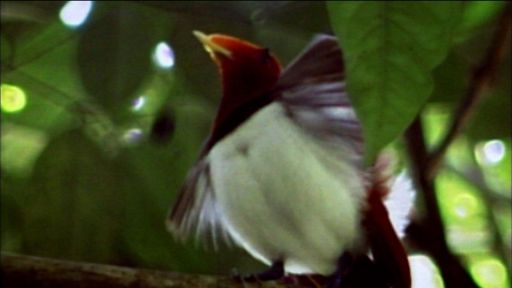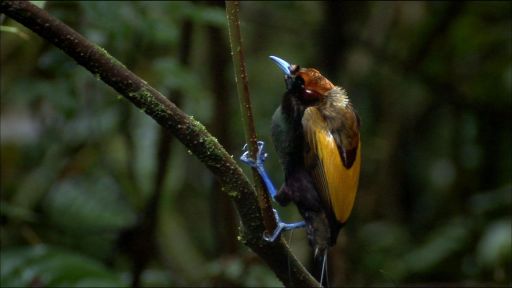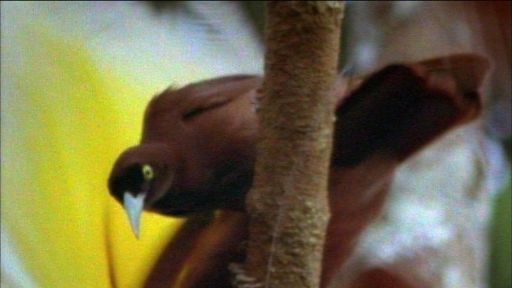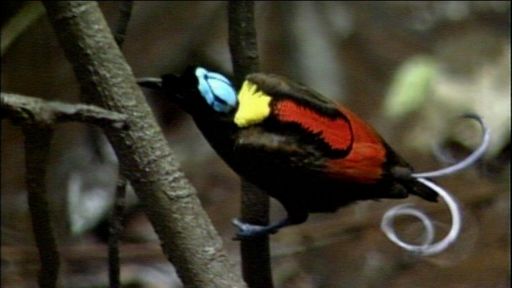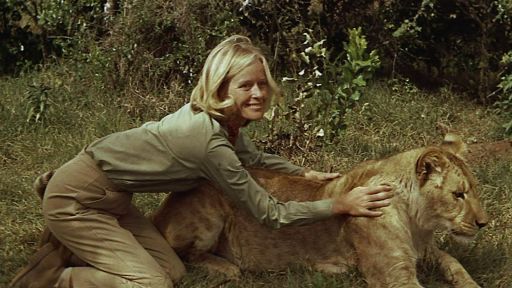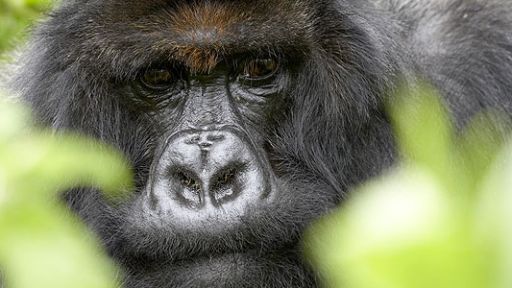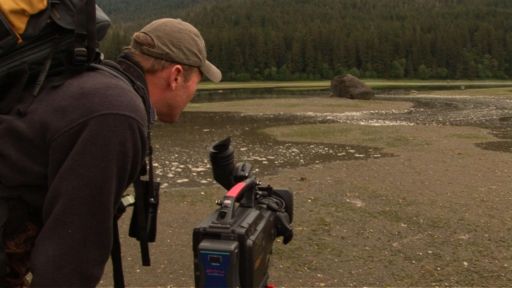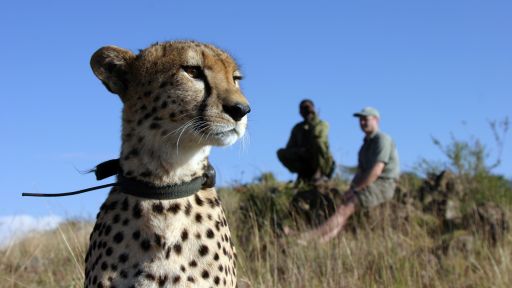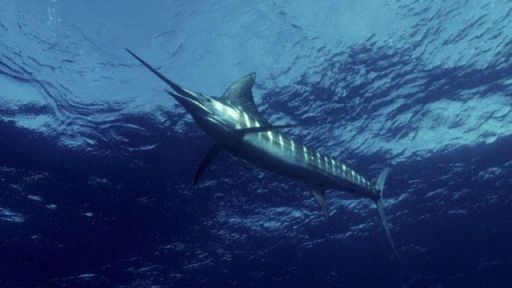TRANSCRIPT
DAVID ATTENBOROUGH: Imagine creatures so beautiful that people thought they had come down directly from heaven...
So striking that the first Europeans to see them thought they could only have escaped from the Garden of Eden.
In fact, that Eden was New Guinea -- one of the last inhabited islands to be explored by Europeans.
And it remains virtually the only place where you can see these wonderful creatures.
They were birds, but unlike birds that anyone had ever seen before.
They brought the image of beauty almost to the edge of absurdity.
And their displays were even more extraordinary and bizarre than their appearance, some of the most complex to be found in the animal kingdom.
They may not have come from the Garden of Eden, but they certainly deserve the name that the first European scientists gave them -- the birds-of-paradise.
Yet much of what they do is still unknown.
More than 150 years after the first scientific observations of these creatures, in spite of innumerable expeditions and countless hours of scientific observation, we are still only catching glimpses, tantalizing glimpses, of these heavenly creatures.
A new generation of scientists and film crews are attempting to put that right.
But these remarkable birds don't give up their secrets easily.
ATTENBOROUGH: Another expedition is setting off to look for birds-of-paradise.
But this one is different.
This one is being mounted by the New Guinea people themselves.
A new generation of local conservationists are concerned that paradise bird numbers may be falling.
[Recorded bird calls playing] [Calling] This team is led by Miriam Supuma.
With her is bird expert Paul Igag.
SUPUMA: Ah, I've got my knickers wet!
[Laughs] ATTENBOROUGH: Miriam's love of nature began in a small village school in the mountains.
To follow that passion, she learned English, got herself to university, and finished her ecology field work in Australia.
Over the next three months, she aims to see and document 10 birds-of-paradise species.
She has agreed to let our camera crew go with her.
They are starting with the smallest of the family -- the King Bird.
Miriam searches for signs.
You have to know what to look for -- and she does.
SUPUMA: You can see peck marks on this fruit here.
[Bird calling] ATTENBOROUGH: That's his call.
But she just can't see him.
SUPUMA: It tends to like this area.
One of the reasons is because of the light coming through.
They're show-off birds, so they like to show their plumage, and the light complements their bright plumage.
ATTENBOROUGH: The signs are good.
They decide to build a hide.
It must be big enough to seat her and the camera crew.
But there's a problem.
A dead banana tree blocks the camera's view.
Miriam has it gently pruned back.
[Birds calling] She's confident the birds will return.
This is the mating season, when they become less shy.
She discovered this when she was still a student.
Working in the forest, early one morning, she spotted a bird-of-paradise high in the tree tops and below it, another, preening its plumes in the morning sun.
[Calling] And then they displayed.
The sight changed her life.
SUPUMA: On that day, I noticed there were about six or seven birds-of-paradise, singing and dancing, and it just continued for five or ten minutes.
I stopped what I was doing -- I was measuring trees at the time -- and I was looking at it, just staring at it in awe.
[Calling continues] ATTENBOROUGH: Naturalists fall in love with nature, and then come back for more.
Seven years on, and experience has taught Miriam that the best way to observe the male King Bird is to find his display perch and then wait for him to arrive.
Teaches you a lot of patience, doesn't it?
ATTENBOROUGH: And patience can often pay off.
Oh, there it is... Wow!
The King Bird.
It's facing that way, with its back towards us.
You can see the red back.
It's gone up into the canopy.
ATTENBOROUGH: He's a deep chili-pepper red, with a snow-white breast.
Two long quills sprout from his tail, each tipped by a green disk like a coin.
That was a rare moment.
Oh, there, there it is again.
Wow!
ATTENBOROUGH: She's thrilled.
With other males calling in the forest nearby, Miriam is sure that she's found a good population here.
[Calling] The male King Bird will call to the females in the area.
[Calling continues] If none come, he will perform without them.
After puffing himself up, he flicks his quills above his head and waggles them, making the little disks dance in the air above him.
He's still hoping for an audience.
Undeterred, he ends with a flourish.
He swings upside down and locks his legs.
And then he turns himself into a pendulum.
The King Bird is a soloist.
The males of many other species display in groups.
These are the Greater Birds-of-paradise.
Males assemble every day in one special tree, waiting for a female to arrive.
When one does, they all snap into action.
And she selects the one she prefers.
She's rewarded with a one-on-one -- starting with pecks on the head.
And eventually she accepts him.
While all the males may appear equally gorgeous to our eyes, females apparently detect differences.
What's more, they nearly all mate with the same male.
By selecting the finest plumes in this way, the females have increased the males' beauty generation after generation, and so brought these magnificent dances into existence.
The spectacular beauty of their birds fascinates the people of New Guinea, as I discovered back in 1957.
I knew that the bird-of-paradise plumes were important, and I quickly discovered just how important.
The plumes are the equivalent of money and an essential payment in the bargaining that goes on between families when fixing a wedding settlement... [Men singing in native language] ATTENBOROUGH: And when men want to dance.
And what I saw 50 years ago is still going on today.
[Men singing] ATTENBOROUGH: Goroka Town, in the heart of the mountains.
It's festival time, and feathers are still essential headwear.
Go with the photograph, if you can.
Or the -- ATTENBOROUGH: It's a key moment in the year for Miriam's research.
Look at these and then look at what's on the headdresses.
If you see something like this... ATTENBOROUGH: The feathers of many different species of bird are used in the headdresses, and the team want to find out how many come from birds-of-paradise.
These scenes are not very different from those I filmed myself half a century earlier.
ATTENBOROUGH ON FILM: There were 500 of these men, stamping up and down monotonously and unceasingly.
And as I watched them, I realized that here was the reason why no one had brought us birds-of-paradise.
Miriam wants to see my footage from 1957 so that she can compare the numbers and species used by the dancers then and now.
Each man was wearing the feathers of 30 or 40 birds.
At this one dance, we were seeing the plumes of over 20,000 slaughtered birds-of-paradise.
The desire to possess the beauty of the birds is an ancient obsession, still alive in these tribal lands.
The island of New Guinea is huge.
A thousand miles long, lying between Australia and the equator, it was pushed up from the bottom of the sea way back in geological time.
A few land mammals from Australia managed to get here -- including some marsupials, such as the strange tree kangaroo.
But there are no indigenous carnivorous mammals here.
With fruit growing all the year round, this is indeed a paradise for birds.
Then, some 30,000 years ago, the greatest threat to their existence walked in on two legs.
But today, there are people here whose only aim is to protect the birds.
Paul Igag was brought up on the coast, a fisherman's son.
Paul gave up the fishing life to study biology.
He married a highland girl and stayed up here to pursue his love of forest birds.
[Birds calling] The call of the Raggiana Bird-of-paradise.
You can see a male up there with full adult plumage.
ATTENBOROUGH: He's trying to attract females.
Paul has seen many of the forest's rarest bird species.
He builds platforms in the canopy, where he can sit quietly and wait.
[Calling continues] Some birds are quite bold and seem undisturbed by his presence.
Others are much more wary, like the magnificent Rifle-Bird of paradise.
Paul has been watching the birds intensively for over 15 years.
[Calling] His tracking skills are crucial to the project.
Together, Paul and Miriam start to identify the bird populations that may need protection.
Paul is taking Miriam to a remote village southeast of Goroka.
As I did on my own journey to the interior, they have to cross high mountain ranges, blanketed by forest.
Between these walls of rock lie immense valleys, like the Wahgi.
Hundreds of tribes have lived on the island for thousands of years, separated by these barriers of water and rock.
800 languages have evolved, some as different from one another as English is to Chinese.
The language of Haia Village is spoken only here.
Even today, the only contact between these people and the outside world is the plane that takes away their coffee beans.
It's a warm welcome back for Paul.
He's been coming here for the last few years to help map tribal boundaries.
[Speaking native language] ATTENBOROUGH: This forest belongs to the Haia people.
They have always been hunters -- but now they are helping to record the rich wildlife.
One day, all this may become a protected reserve.
For now, it's hundreds of square miles of untouched mountain forest.
For the villagers, a wildlife reserve could bring work and education.
There's a lot at stake.
The locals' hunting knowledge is invaluable for the project.
Paul and Miriam need to find natural paths and trees in fruit if they are to locate all the threatened species.
The three-foot-long tail feathers of the male Black Sicklebill are the reason why his kind is almost extinct locally.
His plumes fetch the highest prices.
But hunting here has now been banned.
This trip is to find two special birds-of-paradise that are still unprotected by law.
One of them can sometimes be seen in the very early mornings, busy on the floor of the darkest parts of the forest.
Miriam is looking for the Parotia Bird-of-paradise -- a bird with a very special dance.
The male Parotia is most particular about where he dances.
And this could be the place.
Paul is looking for the Magnificent Bird-of-paradise, a bird which also displays close to the ground, and is therefore very vulnerable to hunters.
IGAG: "Well, that's it," I said.
That's the display court, and that's it.
We will not get him there.
We didn't want to spend a long time in that area, because we want to come back and see the bird, so our presence there might, you know, spoil everything.
[Thunder, pouring rain] ATTENBOROUGH: Six inches of rain can fall in a single day on Crater Mountain.
And during the downpours, the birds-of-paradise shelter beneath the leaves.
[Thunder] SUPUMA: I was sitting in the hide, thinking we might not get to see anything because it did rain.
Bloody mosquitoes.
And then I heard a male Parotia.
There were other males calling, as well.
ATTENBOROUGH: Black as the blackest night, he seems to absorb all the light around him.
He is Lawes' Parotia.
On his head, six strange wire-like plumes -- each tipped with a black pennant.
On his chest, a shield of iridescent green and gold.
This is his court, a stage he has carefully cleared so that he can dance unimpeded.
Cleaning away last night's leaf fall is essential housekeeping.
A female arrives.
She is comparatively drab, with none of his flashy glamour.
She's touring all the courts in the neighborhood to choose a mate.
He sets about impressing her.
But one of his rivals has called by, uninvited.
And he is followed by others.
More females arrive and take up seats for the performance.
[Squawking] Tensions rise, but nobody dances.
[Squawking] Suddenly, one of the intruders mates with a female.
Another male does the same.
The court has become a free-for-all.
It's not what Miriam expected.
They just went straight into mating without even any dance at all.
It's almost like skipping dinner and getting straight into dessert.
It would be nice to see them actually dancing.
Sitting in the hide for three or four hours isn't fun with all the mosquitoes, and you'd like to go away feeling that you've seen the whole performance.
ATTENBOROUGH: It is possible that the birds have been disturbed by the presence of humans in the forest around.
It will be several days before they venture back to try another filming session.
Paul has been searching for the Magnificent Bird-of-paradise for a few days now, listening for their calls and quietly assessing their numbers.
He recently saw one far from here in the town market.
All birds-of-paradise have a street value.
It's not illegal for local people to hunt them or sell them.
They're a way of making some cash.
IGAG: This is a Magnificent Bird-of-paradise.
ATTENBOROUGH: The hunters have mounted the bird's skin, complete with feathers, on a stick, ready to be stuck into a headdress.
Another bird wanders by, a Pheasant Pigeon, feeding on the forest floor.
But this is a female Magnificent, and here's another.
There's the female.
Things look promising.
They can only have come for one reason.
A flicker of gold, and there he is -- the Magnificent Bird-of-paradise.
The male Magnificent is clearing away leaves that have fallen on his court.
Doves and pigeons are helping by picking up a few seeds.
He's stripping away moss and leaves, letting shafts of sunlight into his display court.
He wants to look his best.
IGAG: It's really interesting to see the Magnificent Bird-of-paradise.
The feather itself is quite bright, and you can see it out there.
It's like a flame.
ATTENBOROUGH: The stage seems set, but there's a distraction.
Another male.
There's a standoff between the two males.
Then the females take action.
[Squawking] Surprisingly, they charge the intruder... [Squawking] And drive him out.
With his stage now to himself, the court maker can give the most interested female all his attention.
He begins to transform himself for her.
Puffing and pulsing his breast feathers creates a special effect -- an emerald-green, heart-shaped breast shield to dazzle her with.
Next to his eyes, two tiny iridescent spots flash at her.
You might think that this little jewel of a bird was one of a kind.
But he has a cousin on an offshore island that in isolation has changed into a different species -- Wilson's Bird-of-paradise.
Both have those sickle-shaped tail quills.
But his cousin has a bald head, and his scalp is blue.
And whereas the Magnificent's back is a golden yellow, his cousin's back has turned red.
Different populations, isolated in different areas, are still evolving different plumes to match the tastes of the local females.
IGAG: We were thinking, when is mating taking place, when is mating taking place?
It's sort of an activity that probably goes on for a while, until only the birds know when is the right time.
ATTENBOROUGH: It's Paul's first sighting of a Magnificent Bird-of-paradise -- after 15 years working in the forest.
Several days later, Miriam returns to the court of the Parotia.
The male is back on his dancing ground.
But the camera can't get a proper view.
A log has dropped.
It's too late to build another hide.
Instead, the crew has to make adjustments.
The log is propped up.
There is a risk, of course, that the court owner will notice the change and never come back.
But he does.
It's a very promising start.
He removes little bits of litter and prepares to perform one of the most complex dance routines in the whole bird world.
But now there's trouble -- an intruder, another male.
[Squawking] But the owner of the court is not put off.
And that is how it's supposed to be.
Seeing the Parotia dance gives Miriam an insight into the intimate rituals of her people.
SUPUMA: When I was sitting in the hide, I was thinking back to people here in Papua New Guinea.
They have these gatherings where they go into a hut and sit in a row, alternating male-female-male-female.
They start singing and rocking their heads back and forth...
It's like picking out someone they fancy.
And I can understand why, when they do their traditional dance, they put the feathers on.
Probably to them, represents something, you know, that's kind of sacred they find in the forest, and because of the bird's behavior -- it's a very unique and special bird.
ATTENBOROUGH: Papuans are steeped in the mysteries of their tribal past.
Nobody knows it all, only that birds and humans have been together for thousands of years.
The desire to possess the beauty of the birds is an ancient obsession.
Everywhere, the paradise birds are hunted and their plumes treasured and stored on the rafters in houses throughout the land.
These precious feathers are kept in bamboo tubes, ready to adorn the bodies of a new generation, to help them begin a new cycle of human life.
[Drums playing] [People singing] Miriam and her team are counting feathers.
She wants clues as to which birds are suffering most from hunting.
[Supuma speaking native language] ATTENBOROUGH: They question the dancers about where and how they got their feathers.
[Man replying in native language] ATTENBOROUGH: She's keen to know about one species in particular.
SUPUMA: What I have here is the Blue Bird-of-paradise.
I've seen it worn by some of the highlanders on their headdress.
ATTENBOROUGH: It's a very vulnerable bird, and its feathers fetch high prices.
SUPUMA: It's been hunted heavily in the past.
I haven't seen it display in the wild, and if I were, that would be something.
ATTENBOROUGH: In the meantime, beliefs die hard.
But among them, there are some that can actually protect the birds.
[Ghostly voices] There's a fear of angering the spirit world.
And where spirits live, hunters will not go.
IGAG: Imagine a mountain that is covered with forest.
No one goes up there.
People believe that there is a spirit up there.
People don't touch that mountain, so that forest remains intact.
For us working in conservation, it works perfectly.
It leaves that place unspoiled.
ATTENBOROUGH: Early one morning, Paul and Miriam begin climbing up to part of the forest where hunters fear to tread, to look for two special birds-of-paradise.
Different species live at different altitudes, depending on the rainfall and the type of fruit trees growing at different levels.
Even today, not a great deal is known about these birds -- where they nest; how they raise their young; whether species overlap, even interbreed.
Biologists are still trying to find the answers.
Field work like this brings its own delights.
SUPUMA: I got my knickers wet!
[Laughs] SUPUMA: It's a challenge in itself to working -- being a researcher and working in a remote area.
Sometimes you get to spend months and months out in the field, and you miss your comforts in life.
The tradeoff is that you get to listen to birds singing in the morning... You wake up to that every day.
ATTENBOROUGH: Miriam is looking for the Blue Bird-of-paradise.
In undisturbed forest, she hopes to find populations of birds that will be less wary of humans.
Paul is looking for the Superb Bird-of-paradise, whose breast feathers are so sought after.
It calls in the dense mid-canopy, but it displays on or near the ground, and in open spaces.
A large fallen tree -- and there's a hopeful sign here.
On one side, some of the moss is missing.
Small dancing feet could have rubbed it away.
This could be a good place to watch for the Superb.
But the weather is not good.
[Raining] [Speaking native language] ATTENBOROUGH: In wind and rain, birds, like people, take shelter.
There is nothing to be done except wait for a break in the weather.
It's now getting late in the birds' breeding cycle.
Their displays are becoming less frequent and intense.
It's been six days since the team built the hide beside the fallen tree.
Paul arrives in the rain at 5:00 each morning and leaves in the rain at noon.
And the fallen tree is just remaining a fallen tree.
In a damp thicket, Miriam is keeping vigil for the Blue Bird.
Day seven, and finally a visitor to Paul's log -- but it's only a Ground Dove.
[Bird calls] That's the call of the Superb.
He's making an advertising call from a high point.
[Calling continues] And it's not far from Paul's hide.
[Bird calling] SUPUMA: That's nearby.
ATTENBOROUGH: After many days of solid rain, the birds are quickly becoming active again.
Miriam's bird, a Blue Bird, has come to the edge of the thicket and is calling.
SUPUMA: I wonder if that's the same bird or two different birds.
[Bird calling] ATTENBOROUGH: Paul's bird is calling nonstop.
And there he is.
There's that fabulous green-and-blue breast shield.
He's trying to entice a female down from the canopy.
[Calling] [Second bird calls] ATTENBOROUGH: But that's not her.
The call seems to irritate him.
And there she is.
He transforms himself.
A black cape appears behind his head.
Then he moves into a trance-like state and he dances.
Success.
And here is that performance again.
All is not what it seems.
Those spots that look like eyes are, in fact, feathers, reflecting the dawn light.
That clicking noise is not his wings striking the wood, but quills flicking against one another -- like the clicking of fingers.
Bizarre and beautiful.
No wonder his breast shield is so treasured by human dancers.
It's day nine.
Miriam is still waiting for the Blue Bird to appear in the thicket in front of her.
[Bird calling] He calls from nearby trees.
Could the hide be putting him off?
At last, he comes... And takes up his position on his favorite branch in his own special way.
SUPUMA: Wow!
It's our lucky day.
I've never seen anything like this -- this is crazy.
ATTENBOROUGH: It's a performance of such exquisite beauty, it seems unfair that no female is here to see it.
He's serenading like a love-struck Romeo, but the balcony above is empty.
One can only sympathize.
Male birds-of-paradise have played to empty seats for hundreds of thousands of years.
It's been their special evolutionary destiny to spend their lives displaying their beauty.
It's what makes them so extraordinary.
The next morning, the male Blue Bird returns.
Suddenly he stops.
[Calling] Miriam has seen something off camera.
There's a female in the tree above.
SUPUMA: She's here, she's here!
ATTENBOROUGH: And now she's here, his performance changes.
His pulsing gives way to a subtle low buzzing that also throbs.
It's barely audible to human ears, but the microphone picks it up loud and clear.
It's an unearthly sound that he only makes in her presence.
There's nothing like it to be heard anywhere else in the bird world.
SUPUMA: The vibrating movement and the puffing of the chest to expose the black patch was, you know, something intimate, and it only did that when the female was next to him.
Just looking at it was -- gave you a sense of guilty pleasure just looking at them, it was something intimate going on between the two birds.
ATTENBOROUGH: Moving closer, but without touching him, the female seems to be studying every feather of his vibrating body.
Surely he's done enough...
But no.
SUPUMA: And then all of a sudden she just flew away, and it was like, "ugh!
Come on!"
For the male to go through all that, it was excruciating, just to put all that energy into it.
And I think for him it was like, "Okay, maybe we'll try another day."
Yeah.
ATTENBOROUGH: Yet his effort is the whole point.
Males can but try their best.
The rest is up to the females, and it was ever thus.
[Calling] The plaintive call of the rejected male echoes across the mountains.
These dances have been performed here for millennia, but for how much longer?
Miriam and her team have made a good start on their project.
But much more work needs to be done.
SUPUMA: We need numbers.
In order to do that, we need to do research, so we need numbers so that we can see how they are fluctuating with time and with the different factors -- human population growth, hunting, disturbance, forest clearing -- so we can understand their conservation status better.
ATTENBOROUGH: Meanwhile, to preserve the feathers that the dancers already have, the team are handing out mothballs.
These can be put inside the bamboo tubes in which the feathers are stored and so save them from decay.
That should reduce the demand for freshly hunted plumes.
SUPUMA: If we were to lose one of these birds, or two, it could mean the loss of something that people hold close to their hearts.
ATTENBOROUGH: Papua New Guineans are now caring for their birds in a new way.
The birds have survived the tribal culture for thousands of years, but the world is changing, and their forest is changing.
Miriam and Paul are starting a new conservation movement to ensure that generations to come will still be able to delight in these astonishing birds-of-paradise.
To learn more about what you've seen on this "Nature" program, visit pbs.org.

